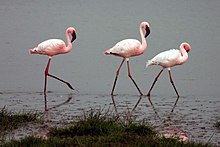
Back كاروتين Arabic Карацін Byelorussian Каротин Bulgarian ကာရိုတိဉ်း BLK Karoten BS Carotè Catalan Karoteny Czech Karotin Danish Carotine German Καροτένιο Greek



The term carotene (also carotin, from the Latin carota, "carrot"[1][2]) is used for many related unsaturated hydrocarbon substances having the formula C40Hx, which are synthesized by plants but in general cannot be made by animals (with the exception of some aphids and spider mites which acquired the synthesizing genes from fungi).[3] Carotenes are photosynthetic pigments important for photosynthesis. Carotenes contain no oxygen atoms. They absorb ultraviolet, violet, and blue light and scatter orange or red light, and (in low concentrations) yellow light.
Carotenes are responsible for the orange colour of the carrot, after which this class of chemicals is named, and for the colours of many other fruits, vegetables and fungi (for example, sweet potatoes, chanterelle and orange cantaloupe melon). Carotenes are also responsible for the orange (but not all of the yellow) colours in dry foliage. They also (in lower concentrations) impart the yellow coloration to milk-fat and butter. Omnivorous animal species which are relatively poor converters of coloured dietary carotenoids to colourless retinoids, such as humans and chickens, have yellow-coloured body fat, as a result of the carotenoid retention from the vegetable portion of their diet.
Carotenes contribute to photosynthesis by transmitting the light energy they absorb to chlorophyll. They also protect plant tissues by helping to absorb the energy from singlet oxygen, an excited form of the oxygen molecule O2 which is formed during photosynthesis.
β-Carotene is composed of two retinyl groups, and is broken down in the mucosa of the human small intestine by β-carotene 15,15'-monooxygenase to retinal, a form of vitamin A. β-Carotene can be stored in the liver and body fat and converted to retinal as needed, thus making it a form of vitamin A for humans and some other mammals. The carotenes α-carotene and γ-carotene, due to their single retinyl group (β-ionone ring), also have some vitamin A activity (though less than β-carotene), as does the xanthophyll carotenoid β-cryptoxanthin. All other carotenoids, including lycopene, have no beta-ring and thus no vitamin A activity (although they may have antioxidant activity and thus biological activity in other ways).
Animal species differ greatly in their ability to convert retinyl (beta-ionone) containing carotenoids to retinals. Carnivores in general are poor converters of dietary ionone-containing carotenoids. Pure carnivores such as ferrets lack β-carotene 15,15'-monooxygenase and cannot convert any carotenoids to retinals at all (resulting in carotenes not being a form of vitamin A for this species); while cats can convert a trace of β-carotene to retinol, although the amount is totally insufficient for meeting their daily retinol needs.[4]
- ^ Mosby's Medical, Nursing and Allied Health Dictionary, Fourth Edition, Mosby-Year Book 1994, p. 273
- ^ "carotene". Online Etymology Dictionary.
- ^ Marmion D, Updated By Staff (2012). "Colorants for Foods, Drugs, and Cosmetics". Kirk-Othmer Encyclopedia of Chemical Technology. doi:10.1002/0471238961.0315121513011813.a01.pub3. ISBN 978-0471238966.
- ^ Green AS, Tang G, Lango J, Klasing KC, Fascetti AJ (2011). "Domestic cats convert ((2) H(8))-β-carotene to ((2) H(4))-retinol following a single oral dose". Journal of Animal Physiology and Animal Nutrition. 96 (4): 681–92. doi:10.1111/j.1439-0396.2011.01196.x. PMID 21797934.
© MMXXIII Rich X Search. We shall prevail. All rights reserved. Rich X Search